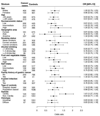Coffee consumption and gastric cancer: a pooled analysis from the Stomach cancer Pooling Project consortium
- PMID: 34545022
- PMCID: PMC8972971
- DOI: 10.1097/CEJ.0000000000000680
Coffee consumption and gastric cancer: a pooled analysis from the Stomach cancer Pooling Project consortium
Abstract
Objective: This study aimed to evaluate and quantify the relationship between coffee and gastric cancer using a uniquely large dataset from an international consortium of observational studies on gastric cancer, including data from 18 studies, for a total of 8198 cases and 21 419 controls.
Methods: A two-stage approach was used to obtain the pooled odds ratios (ORs) and the corresponding 95% confidence intervals (CIs) for coffee drinkers versus never or rare drinkers. A one-stage logistic mixed-effects model with a random intercept for each study was used to estimate the dose-response relationship. Estimates were adjusted for sex, age and the main recognized risk factors for gastric cancer.
Results: Compared to never or rare coffee drinkers, the estimated pooled OR for coffee drinkers was 1.03 (95% CI, 0.94-1.13). When the amount of coffee intake was considered, the pooled ORs were 0.91 (95% CI, 0.81-1.03) for drinkers of 1-2 cups per day, 0.95 (95% CI, 0.82-1.10) for 3-4 cups, and 0.95 (95% CI, 0.79-1.15) for five or more cups. An OR of 1.20 (95% CI, 0.91-1.58) was found for heavy coffee drinkers (seven or more cups of caffeinated coffee per day). A positive association emerged for high coffee intake (five or more cups per day) for gastric cardia cancer only.
Conclusions: These findings better quantify the previously available evidence of the absence of a relevant association between coffee consumption and gastric cancer.
Copyright © 2021 Wolters Kluwer Health, Inc. All rights reserved.
Conflict of interest statement
Figures






References
-
- Boccia S, Sayed-Tabatabaei FA, Persiani R, Gianfagna F, Rausei S, Arzani D, et al. (2007). Polymorphisms in metabolic genes, their combination and interaction with tobacco smoke and alcohol consumption and risk of gastric cancer: a case-control study in an Italian population. BMC cancer 7:206–206. doi: 10.1186/1471-2407-7-206. - DOI - PMC - PubMed

